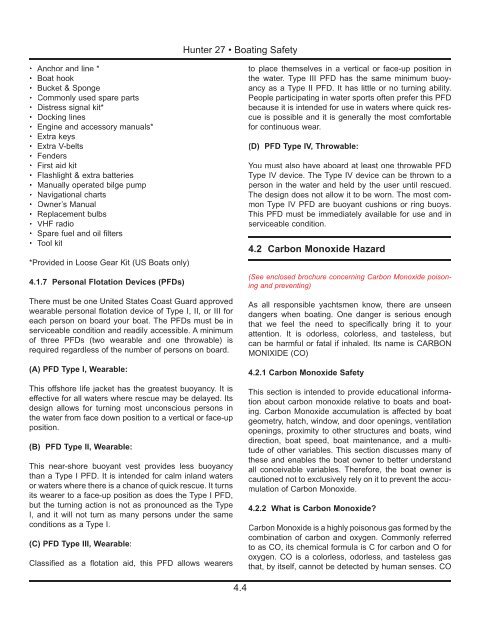27 Operator's Manual.. - Marlow-Hunter, LLC
27 Operator's Manual.. - Marlow-Hunter, LLC
27 Operator's Manual.. - Marlow-Hunter, LLC
Create successful ePaper yourself
Turn your PDF publications into a flip-book with our unique Google optimized e-Paper software.
<strong>Hunter</strong> <strong>27</strong> • Boating Safety<br />
•<br />
•<br />
•<br />
•<br />
•<br />
•<br />
•<br />
•<br />
•<br />
•<br />
•<br />
•<br />
•<br />
•<br />
•<br />
•<br />
•<br />
•<br />
•<br />
Anchor and line *<br />
Boat hook<br />
Bucket & Sponge<br />
Commonly used spare parts<br />
Distress signal kit*<br />
Docking lines<br />
Engine and accessory manuals*<br />
Extra keys<br />
Extra V-belts<br />
Fenders<br />
First aid kit<br />
Flashlight & extra batteries<br />
<strong>Manual</strong>ly operated bilge pump<br />
Navigational charts<br />
Owner’s <strong>Manual</strong><br />
Replacement bulbs<br />
VHF radio<br />
Spare fuel and oil filters<br />
Tool kit<br />
*Provided in Loose Gear Kit (US Boats only)<br />
4.1.7 Personal Flotation Devices (PFDs)<br />
There must be one United States Coast Guard approved<br />
wearable personal flotation device of Type I, II, or III for<br />
each person on board your boat. The PFDs must be in<br />
serviceable condition and readily accessible. A minimum<br />
of three PFDs (two wearable and one throwable) is<br />
required regardless of the number of persons on board.<br />
(A) PFD Type I, Wearable:<br />
This offshore life jacket has the greatest buoyancy. It is<br />
effective for all waters where rescue may be delayed. Its<br />
design allows for turning most unconscious persons in<br />
the water from face down position to a vertical or face-up<br />
position.<br />
(B) PFD Type II, Wearable:<br />
This near-shore buoyant vest provides less buoyancy<br />
than a Type I PFD. It is intended for calm inland waters<br />
or waters where there is a chance of quick rescue. It turns<br />
its wearer to a face-up position as does the Type I PFD,<br />
but the turning action is not as pronounced as the Type<br />
I, and it will not turn as many persons under the same<br />
conditions as a Type I.<br />
(C) PFD Type III, Wearable:<br />
Classified as a flotation aid, this PFD allows wearers<br />
to place themselves in a vertical or face-up position in<br />
the water. Type III PFD has the same minimum buoyancy<br />
as a Type II PFD. It has little or no turning ability.<br />
People participating in water sports often prefer this PFD<br />
because it is intended for use in waters where quick rescue<br />
is possible and it is generally the most comfortable<br />
for continuous wear.<br />
(D) PFD Type IV, Throwable:<br />
You must also have aboard at least one throwable PFD<br />
Type IV device. The Type IV device can be thrown to a<br />
person in the water and held by the user until rescued.<br />
The design does not allow it to be worn. The most common<br />
Type IV PFD are buoyant cushions or ring buoys.<br />
This PFD must be immediately available for use and in<br />
serviceable condition.<br />
4.2 Carbon Monoxide Hazard<br />
(See enclosed brochure concerning Carbon Monoxide poisoning<br />
and preventing)<br />
As all responsible yachtsmen know, there are unseen<br />
dangers when boating. One danger is serious enough<br />
that we feel the need to specifically bring it to your<br />
attention. It is odorless, colorless, and tasteless, but<br />
can be harmful or fatal if inhaled. Its name is CARBON<br />
MONIXIDE (CO)<br />
4.2.1 Carbon Monoxide Safety<br />
This section is intended to provide educational information<br />
about carbon monoxide relative to boats and boating.<br />
Carbon Monoxide accumulation is affected by boat<br />
geometry, hatch, window, and door openings, ventilation<br />
openings, proximity to other structures and boats, wind<br />
direction, boat speed, boat maintenance, and a multitude<br />
of other variables. This section discusses many of<br />
these and enables the boat owner to better understand<br />
all conceivable variables. Therefore, the boat owner is<br />
cautioned not to exclusively rely on it to prevent the accumulation<br />
of Carbon Monoxide.<br />
4.2.2 What is Carbon Monoxide?<br />
Carbon Monoxide is a highly poisonous gas formed by the<br />
combination of carbon and oxygen. Commonly referred<br />
to as CO, its chemical formula is C for carbon and O for<br />
oxygen. CO is a colorless, odorless, and tasteless gas<br />
that, by itself, cannot be detected by human senses. CO<br />
4.4

















